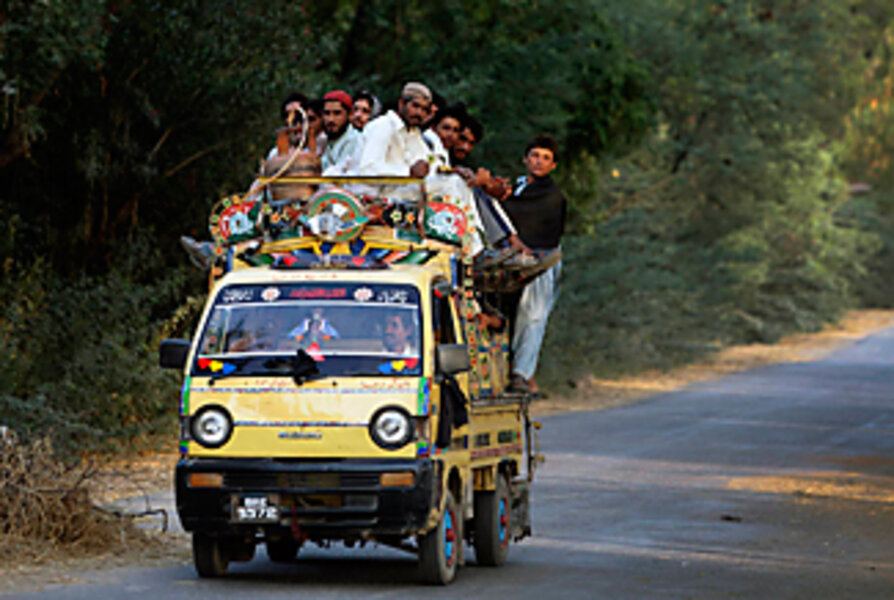Pakistan Army takes fight to Taliban in South Waziristan
| Islamabad, Pakistan
A three-pronged offensive deep into Taliban territory entered its second day on Sunday as heavy fighting between the Pakistan Army and the Taliban left 60 militants and six soldiers dead, according to officials.
Gen. David Petraeus, head of the US Central Command, is due to arrive in Islamabad on Monday for talks with Pakistani commanders regarding what observers have called the "mother of all battles," highlighting the importance Washington attaches to the offensive.
Codenamed "Rah-i-Nijat" or "The Path to Salvation," the operation is taking place in the Taliban heartland of South Waziristan, a barren, mountainous region spanning some 6,620 square kilometers. It has been described as an Al Qaeda safe haven where 80 percent of terrorist attacks in Pakistan are planned.
According to retired Brig. Shaukat Qadir, a military analyst, securing the territory will be crucial in preventing militants from carrying out the kind of deadly attacks that have killed more than 150 Pakistanis over the past two weeks.
"After [Swat Valley], this was the last bastion that was available to the terrorist structure in Pakistan. It means they will not have any territory they will be able to fall back upon," he says.
The country is also bracing for retaliatory attacks with major cities on high alert. Nearly 100 arrests of suspected terrorists were made in the garrison city of Rawalpindi on Monday while a search operation was conducted in the vicinity of the Army's General Headquarters, which militants were able to successfully storm last week. In the eastern city of Lahore, three private schools were closed due to security threats.
Army encircles Taliban stronghold town
According to Express 24/7, a private news channel, the military is closing in on the town of Makeen, a militant stronghold in South Waziristan, from three directions: Razmak to the north, Shakai to the southwest, and Jandola to the southeast. The area is also being bombed according to reports.
The Army claims to have destroyed six anti-aircraft gun positions and numerous hideouts, though these claims have not been independently verified.
Two divisions, totaling 28,000 troops are engaged in the battle, while estimates of enemy numbers vary. There are thought to be between 10,000-20,000 Mehsud tribesmen behind their leader Hakimullah Mehsud, who is also chief of the Pakistani Taliban. In addition, there are believed to be a core of foreign fighters, predominantly Uzbek, who number in the hundreds and are crucial in giving Hakimullah an edge, according to Qadir, the analyst.
"They are basically out-sourced Al Qaeda fighters, they are dedicated and fierce and allow Hakimullah to stamp his authority," he says.
How this offensive will be different
The Army will be familiar with the terrain having conducted operations in South Waziristan in 2004, 2005 and 2008, only to later retreat or negotiate peace deals with the enemy.
However, unlike in those years, the Army will benefit from the backing of the public and soldiers no longer feel they are fighting a war that is not theirs, says Qadir. "In earlier incursions, you had an instance where 208 soldiers surrendered to only a handful of militants. It was a moral revolt – they felt it was [former military ruler] Musharraf's war," he says.
The military will also benefit from air cover, greater numbers, assistance from the United States in terms of night-vision equipment, and the fact it has managed to keep onboard other powerful militant commanders in the region, including Maulvi Nazir in South Waziristan and Hafiz Gul Bahadur in North Waziristan, who have pledged to remain neutral, says Dr. Rifaat Hussain, a security analyst at the Quaid-e-Azam university.
Still, their word cannot be entirely relied on given the fickle nature of militants loyalties. The enemy will be well dug in, on its home turf, and will benefit from a "short-supply line" from neighboring Afghanistan, adds Dr. Hussain.
Tens of thousands of refugees flee
The army will also be hoping to wrap-up the offensive before the onset of winter hampers troops and makes life unbearable for refugees fleeing the area. More than 100,000 residents have so far fled the fighting, Col. Basim Shahid of the Army support group told the media. A spokesperson for the United Nations told Express 24/7 that 21,000 refugees had been registered in the last five days alone.
A long, drawn out confrontation punctuated by ongoing terror attacks in major cities may also start to sap public opinion and lead to calls for a renewed cease-fire, according to some analysts.
Ayesha Siddiqa, author of "Military Inc.: Inside Pakistan's Military Economy" says that even if the military is eventually successful in its battle in the tribal regions, Pakistan will not be able to quell the threat of homegrown terrorism until it tackles the problem of militancy in southern Punjab. Militants from this region have long been trained by Pakistan's security forces to wage war in Kashmir but have in recent years developed deep links with Al Qaeda and the Taliban. They are still able to carry out their activities with relatively little scrutiny, she says.
Qadir, however, has a different view: "Southern Punjab is the hotbed of religious extremism. They provide fresh blood for the terrorists but the training for terrorists is in South Waziristan. There are no training facilities in Bahawalpur [a town in southern Punjab]."






